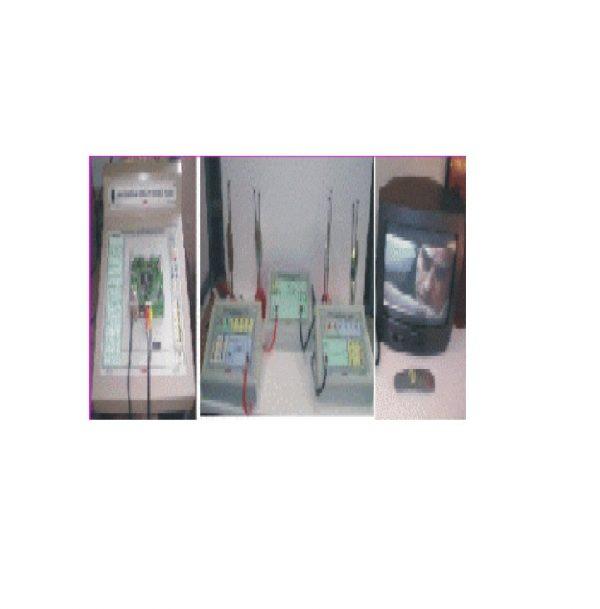Description
LIST OF EXPERIMENTS
Study of
• Direct TV signal broadcasting via satellite:orbital path, geostationary
• satellites, emitted power, covering map, transmission standard, coding systems.
• Functional diagram of a reception for TV satellites
• Components characteristics: parabolic antenna, illuminator, LNB converter, receiver remote control. Characteristics of the signal converted to intermediate frequency
• Audio/video decoders operation: wave-from analysis
• Video decoder programming
• Audio decoder programming
Technical Specifications External Unit:
• Digital Satellite Receiver outputs: video, audio, RF
• Structure: compact cabinet with lift able cover with all the electronic parts, the test points, the fault simulator; and the block diagram of the circuit.
• Fault simulator: various faults insert able by means of switches
• Test points; various test points mounted on panel and directly connected to the circuits of the equipment
• LNB
• Digital Receiver
• RG-6 cable
• F5 connector
Reflector
Type
offset
Instruction Manual
Step-By-Step detailed instruction manual.
Offset Angle
22.75 0
Diameter Short Axis
90cm
Diameter Long Axis
99cm
Aperture Efficiency
75% min.
KU – Band Gain @12.5 GHz
38.24 dB
F/D Ratio
0.65
Focus Length
492 mm
Material
Galvanized Steel
Finish
Polyester Powder Coating
Color
Cool Grey
MOUNTING
Mounting Type
Ground, Pole & Wall Mount
Adjustment Type
AZ / EL
Elevation Angle Range
12° – 72°
Azimuth
0° – 360°
Material
Steel / Galvanized Steel
Finish
Polyester Powder Coating
Color
Cool Grey
Pole Diameter Acceptable
38 – 65 mm
Net Weight
6kgs
LNB SPECIFICATION:
Accessories(optional):
• Up- Link Transmitter
• Down-Link Receiver
• Power supply: 230 VAC, 50 Hz MAINS OPERATED.
• Dimensions: 45cm x 45cm x 18cm
• Weight: 6kgs(approximately) .
FEATURES :Lab Satellite receiver trainer(model X9A) comes with Uplink Transmitter, Downlink Receiver, and Satellite Transponder with antennas which can be demonstrated in a class room environment has the following features
• XINC WIRELESS PROCESSOR
• HARDWARE MULTITHREADED
• 16 BIT RISC
• RF TRANSMITTER & RECEIVER:
• 1 Mbps FSK Digital Radio
• Frequency Hoping
• Versatile RF Protocol
• Adaptive Audio CODEC
• Detachable Antenna
• Low Power Consumption
• FREQUENCY :2.4 GHz to 2.48 GHzs
LNB
Low Band
High Band
Input Frequency Range
10.7 ~ 11.7 GHz
11.7 ~ 12.75 GHz
Output Frequency Range
950 ~ 1950 MHz
1100 ~ 2150 MHz
LOW Frequency
9.75 GHz
10.6GHz
Conversion Gain
50 dB (Min.)
63 dB (Max.)
Cross Pol. Isolation
22 dB (Min.)
28 dB (Max.)
Noise Figure
0.5 dB (Typ.)
F/D Ratio
0.6
Input Reflector Type
Offset
Gain Flatness
+/- 0.5 dB / 26 MHz
L.O. Frequency Stability:
(+25°C)
+/- 1 MHz
(-40°C ~ +60°C)
+/- 2 MHz
L.O. Phase Noise:
(1 KHz Offset)
-50 dBc/Hz
(10 KHz Offset)
-75 dBc/Hz
(100 KHz Offset)
-95 dBc/Hz
Image Rejection
40 dB (min.)
Output VSWR
2.0 : 1 (max)
Output Connector
75Ohm F Type Female
D.C. Power Supply
10.5 – 20.0 V
D.C. Power Consumption
120 mA (Max.)
Polar Switching Voltage
Vertical
10.5 ~ 14.0 V
16.0 ~ 20.0 V
Band Switching
Low Band
0KHz
High Band
22KHz+/-4KHz Continuous tone signal
Operating Temperature
-40°C ~ +60°C
Accessories(optional):
• Up- Link Transmitter
• Down-Link Receiver
• Power supply: 230 VAC, 50 Hz MAINS OPERATED.
• Dimensions: 45cm x 45cm x 18cm
• Weight: 6 Kgs (approximately) .
FEATURES :
Lab Satellite receiver trainer(model X9A) comes with Uplink Transmitter, Downlink Receiver, and Satellite Transponder with antennas which can be demonstrated in a class room environment has the following features
• XINC WIRELESS PROCESSOR
• HARDWARE MULTITHREADED
• 16 BIT RISC
• RF TRANSMITTER & RECEIVER:
• 1 Mbps FSK Digital Radio
• Frequency Hoping
• Versatile RF Protocol
• Adaptive Audio CODEC
• Detachable Antenna
• Low Power Consumption
• FREQUENCY :2.4 GHz to 2.48 GHzs




Reviews
There are no reviews yet.